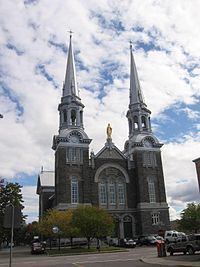Country Canada RCM None Settled 1674 Area 7.7 km² Local time Sunday 9:04 PM | Region Capitale-Nationale Agglomeration Quebec City Constituted January 1, 2006 Population 16,745 (2011) Province Québec | |
 | ||
Weather -2°C, Wind N at 5 km/h, 63% Humidity Points of interest Récréofun, Centre Fun Carie Factory, Parc Cyrille‑Duguay | ||
L'Ancienne-Lorette is a city in central Quebec, Canada. It is a suburb of and an enclave within Quebec City. It was merged with Quebec City on January 1, 2002 as part of a 2000–2006 municipal reorganization in Quebec, but after a 2004 referendum it was reconstituted as a separate city on January 1, 2006.
Contents
- Map of LAncienne Lorette QC Canada
- History
- Demographics
- Economy
- Notable people born in LAncienne Lorette
- References
Map of L'Ancienne-Lorette, QC, Canada
Its history dates back to 1674 when a group of Hurons fleeing war with the Iroquois settled there under the protection of the French. They left after a few decades and French settlers took over the land.
History
A colony started when the Jesuit Pierre Chaumonot in 1674 when he built a chapel for the Hurons. Following his third and final trip to the shrine of Loreto in Italy, Chaumonot was cured of a terrible headache. In gratitude, he placed the colony under the patronage of Our Lady of the Annunciation, but it is still commonly called Lorette.
In 1697, the Hurons left in search of better land for hunting and fishing. Afterwards the site became known as Vieille-Lorette ("Old Loreto") or Ancienne-Lorette ("Former Loreto"). A new location became known as Nouvelle-Lorette ("New Loreto") or Jeune-Lorette ("Young Loreto"), and roughly corresponds to the Loretteville of today. A year later in 1698, the Parish of Notre-Dame-de-l'Annonciation was established.
In 1948, the place was incorporated as the village municipality of Notre-Dame-de-Lorette. In 1967, it gained town status and was took back its original name, L'Ancienne-Lorette, to distinguish itself from a Notre-Dame-de-Lorette Lac-Saint-Jean region.
Until 1971, L'Ancienne-Lorette was the gateway to Quebec's International Airport, which therefore used to be known as L'Ancienne-Lorette Airport. But in 1971 the rural section of the town that included the airport was annexed by Sainte-Foy.
On January 1, 2002, L'Ancienne-Lorette was merged with Quebec City as part of a province-wide municipal reorganization and became part of the Laurentien borough of that city. After a 2004 referendum it again became an independent city on January 1, 2006.
Demographics
According to the Canada 2006 Census:
Population trend:
In 2006, L'Ancienne-Lorette was 98.9% White, 0.3% Aboriginal, and 0.8% Visible Minorities.
Economy
Quebecair Express, prior to its disestablishment, had its headquarters in the city.
